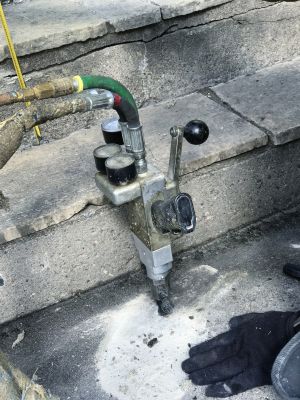Ultimate Selection Of Concrete Lifting Products For Professionals
Find high-performance products tailored for concrete lifting needs that deliver precision and long-lasting results.
 Concrete lifting is a crucial process in maintaining the integrity and safety of various structures, including driveways, sidewalks, floors, and patios. Over time, concrete can settle, crack, or sink due to soil movement, moisture changes, or heavy loads. To address these issues, a range of products are available that facilitate effective and minimally invasive lifting and leveling. These tools and materials are designed to restore the original position of the concrete slabs, improving both appearance and functionality.
Concrete lifting is a crucial process in maintaining the integrity and safety of various structures, including driveways, sidewalks, floors, and patios. Over time, concrete can settle, crack, or sink due to soil movement, moisture changes, or heavy loads. To address these issues, a range of products are available that facilitate effective and minimally invasive lifting and leveling. These tools and materials are designed to restore the original position of the concrete slabs, improving both appearance and functionality.
Top Overall Option
Polyurethane Foam Injection System
A versatile and minimally invasive solution, polyurethane foam injection systems are widely used for lifting and leveling sunken concrete. They involve injecting high-density foam beneath the slab, which expands to fill voids and gently lift the concrete to its original position. These systems are appreciated for their quick application, minimal surface disruption, and long-lasting results when properly installed.
Types of Products For Concrete Liftings
Polyurethane Foam Injection Kits
Pre-packaged kits designed for injecting foam beneath concrete slabs to lift and level uneven surfaces.
Mudjacking Equipment
Tools and materials used for slurry-based lifting methods that raise sunken concrete by pumping a mixture beneath the slab.
Mechanical Jacking Systems
Heavy-duty jacks and hydraulic systems used for lifting large or heavily settled concrete structures.
Polyurethane Foam Expanders
Specialized agents that help control foam expansion during injection to ensure precise lifting.
Concrete Surface Patches
Repair products for filling cracks and surface imperfections after lifting procedures.
Crack Repair Sealants
Sealants designed to prevent water ingress and further deterioration after lifting repairs.
Lift and Level Adhesives
Adhesives that provide additional bonding strength during repair or reinforcement of lifted slabs.
Soil Stabilizers
Products used to improve soil stability beneath concrete to prevent future sinking.
Hydraulic Pressure Pumps
Equipment used to generate the necessary force for mechanical lifting of concrete slabs.
Lift Anchors and Brackets
Hardware used to secure and stabilize concrete during or after lifting procedures.
Void Fill Materials
Materials used to fill gaps beneath slabs to prevent future settling after lifting.
Rapid Curing Resins
Resins that harden quickly to stabilize and reinforce concrete after lifting.
Leveling Screeds
Tools for smoothing and finishing concrete surfaces after lifting or patching.
Vibration and Compacting Tools
Equipment used to ensure proper compaction of materials during repair processes.
Surface Sealers
Protective coatings that seal the surface after repairs to prevent water damage.
Popular Choices
Widely used for their ease of application and effective lifting capabilities on residential slabs.
Commonly selected for large-scale commercial repairs due to their capacity and efficiency.
Popular for heavy-duty projects requiring precise and substantial lifting force.
Frequently chosen for post-lifting surface repairs to prevent water infiltration.
Commonly used to restore the surface after lifting and leveling procedures.
Popular for preventing future settling in high-traffic or unstable areas.
Often used during repair work to ensure proper compaction of materials.
Selected for protecting repaired surfaces from moisture and wear.
Utilized for securing slabs during and after the lifting process for added stability.
Commonly used to fill gaps beneath slabs to support long-term stability.
Popular for quick stabilization after lifting operations.
Frequently employed to achieve smooth, even surfaces after repairs.
Many of these products are suitable for different scales of projects, from small residential repairs to larger commercial applications. They often incorporate innovative techniques such as polyurethane foam injection, mudjacking, or mechanical jacking systems. The choice of product depends on factors like the extent of the damage, the type of concrete, and the desired longevity of the repair. Proper application and selection of the right products can help prevent further deterioration and extend the lifespan of the concrete surfaces.
When considering concrete lifting products, it's important to evaluate their ease of use, compatibility with existing materials, and safety features. Some systems are designed for DIY use, featuring user-friendly instructions and minimal equipment requirements. Others may require professional installation but offer higher precision and durability. Additionally, assessing the potential for future movement or settling can influence the choice of product, ensuring the solution remains effective over time.
Investing in quality concrete lifting products can lead to safer, more attractive surfaces that require less maintenance. Whether dealing with minor unevenness or significant sinking, selecting the appropriate tools and materials is essential for achieving reliable results. Consulting with specialists or reading detailed product descriptions can help in making informed decisions tailored to specific project needs.
Key Buying Considerations
- Type of concrete damage and extent of sinking or cracking
- Project size and whether a DIY or professional approach is preferred
- Compatibility of the product with existing concrete materials
- Ease of application and required skill level
- Long-term durability and stability of the repair solution
- Speed of curing or setting time
- Potential for future movement or settling in the area
- Cost-effectiveness and overall budget constraints
- Safety features and ease of handling during application
- Availability of technical support or instructions
- Environmental conditions at the site, such as moisture or temperature
- Compatibility with other repair or sealing products
- Impact on surrounding structures or landscaping
- Reputation and reviews of the product or system
- Warranty or guarantee offered by the manufacturer
